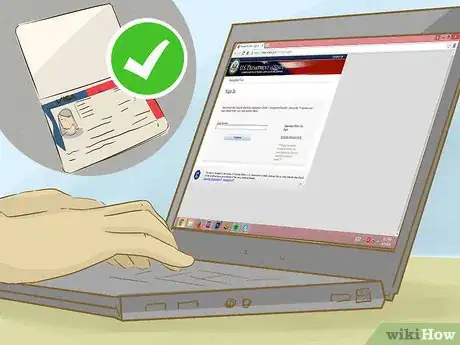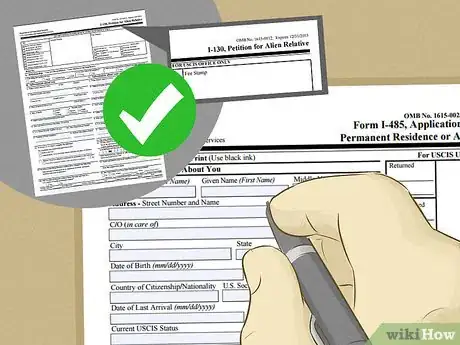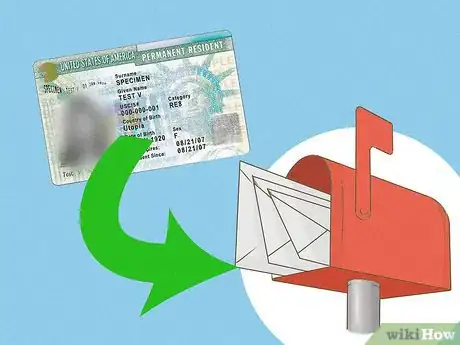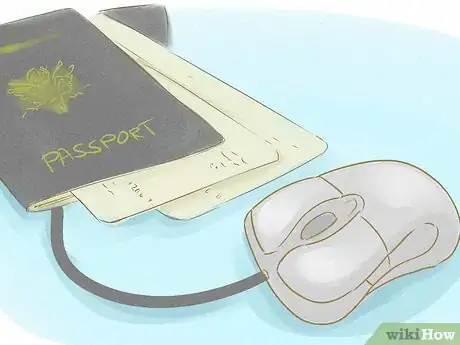X
This article was co-authored by Lahaina Araneta, JD. Lahaina Araneta, Esq. is an Immigration Attorney for Orange County, California with over 6 years of experience. She received her JD from Loyola Law School in 2012. In law school, she participated in the immigrant justice practicum and served as a volunteer with several nonprofit agencies.
This article has been viewed 14,180 times.
Living in the United States is not for everyone. Maybe you found a job in a different country, or you want to marry and live with someone outside the U.S. Whatever your reasons, you can abandon your green card easily. Complete the necessary paperwork and submit it to your nearest embassy or consulate.
Steps
Method 1
Method 1 of 2:
Giving Up Your Green Card
-
1Download Form I-407. You can get this form and its instructions from the USCIS website: https://www.uscis.gov/i-407. Alternately, you can schedule an appointment with your local embassy, consulate, or port of entry and fill out the form there.[1]
-
2Enter requested information. You can type your information directly into the form or print neatly using black ink. Provide all requested information and write “N/A” if anything doesn’t apply. The form will ask for the following information:[2]
- Alien Registration Number (A-Number)
- Your full legal name
- Personal information, such as date of birth, country of birth, and country of citizenship
- The last date you left the U.S.
- Your mailing address
- The reasons for abandoning your green card
- The documents you are surrendering in addition to your green card
- Your original signature
Advertisement -
3Submit your form. Contact your local consulate to check how to submit. Generally, you can submit it in person or by mail. However, if you are somewhere without a local embassy or consulate, you can mail it to the nearest field office.[3] Find the nearest field office at https://www.uscis.gov/about-us/find-uscis-office/international-immigration-offices.
- If you mail in your form, remember to include your green card with it. Always keep evidence of what you mailed, though. Copy the forms, your green card, and proof of mailing. This will help protect you in case your information is not received or processed.
- The I-407 does not have a filing fee. You do not need to submit any payment when you submit your form.
-
4Attend an interview. The consulate might schedule an interview. The purpose is informational: they want to explain the consequences of giving up your green card so you can make an informed decision.[4]
- Typically, an interview is only scheduled if there is some kind of indication that you are not acting voluntarily in your abandonment of the LPR status.
Advertisement
Method 2
Method 2 of 2:
Considering Other Options
-
1Limit your stay outside the U.S. Let’s say you need to leave the U.S. to visit relatives or go to school. Try to limit your absence outside the U.S. to less than six months. If you do, you can easily return to the U.S. without abandoning your green card.
- If you stay outside the U.S. for more than 6 months, things can get tricky. You’ll have to ask for permission to exit and stay abroad for an extended period. This will need to be filed before leaving the U.S.
- If you are outside the U.S. for more than 6 months , the U.S. will presume you have abandoned your green card. You can overcome this presumption. However, you can avoid any troubles by getting a re-entry permit.
-
2Get a re-entry permit instead. Even if you are away for more than a year, you don’t have to give up your green card unless you intend to make a permanent home outside the U.S. Instead, you can get a re-entry permit. You must complete the required paperwork before you leave the U.S.—at least 60 days ahead of time.[5]
- Obtain Form I-131, which you can download at https://www.uscis.gov/i-131. Get the instructions as well.
- Provide two passport-style color photographs of yourself and pay the required fee.
- Unlike a green card, a re-entry permit is valid for up to 2 years after an absence. However, the permit does not guarantee re-entry.
- To reenter the U.S. with the re-entry permit, be prepared to show evidence that the purpose of your stay abroad was consistent with the temporary purpose stated in the I-131 form. Further, be prepared to back that up with evidence of the comparative strength of your U.S. ties compared to your ties abroad.
-
3Talk with an attorney. A qualified immigration attorney can analyze your situation and recommend the best course of action. In the U.S., you can find an immigration attorney by contacting your local bar association and asking for a referral.
- You might be surrendering your green card for tax purposes. If so, consult with a tax attorney.[6]
Advertisement
References
- ↑ http://www.nolo.com/legal-encyclopedia/how-voluntarily-abandon-lawful-permanent-residence-green-card.html
- ↑ https://www.uscis.gov/sites/default/files/document/forms/i-407.pdf
- ↑ https://www.uscis.gov/i-407
- ↑ http://www.alllaw.com/articles/nolo/us-immigration/why-voluntarily-abandon-green-card-i-407.html
- ↑ http://www.alllaw.com/articles/nolo/us-immigration/reentry-permit-process-permanent-residents.html
- ↑ http://www.nolo.com/legal-encyclopedia/how-voluntarily-abandon-lawful-permanent-residence-green-card.html
About This Article
Advertisement



























































